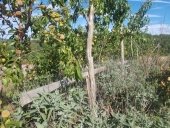Well, I grew up on a farm where the dairy held up for 4 to 5 years after my father ruptured 2 discs in his back working a night job so he could keep farming during the day. After that, the cows were sold off and my father purchased the first hydraulic backhoe in central New York State. We never stopping growing gardens, however. We grew at least 30 to 40 bushels of potatoes until I was nearly out of high school. Then potatoes dropped to a few rows in a large garden. I was given a rototiller around the late 50's and ran those until after college. I read Rodale's Organic Gardening religiously and then took off to Colorado to work as a geotechnical engineer. After I married, we moved back to Denver for a few years and I kept gardening when possible. We bought a house on an acre of land in a village and I turned an old trash spot into a garden using tons of leaves and grass clippings. When the parents passed and the kids graduated, we moved back to the farm where I continue to garden and have found deer far more of an issue than when we kept dogs.
I remember the Jim Crockett's Victory Garden from when I was a teen and could see PBS shows occasionally. For the poster who remembered the Victory Garden shows, here are some publications: Crockett, James Underwood. (1977). Crockett's Victory Garden. New York: Little, Brown. ISBN 978-0-316-16121-3.
Crockett, James Underwood. (1978). Crockett's Indoor Garden. New York: Little, Brown. ISBN 978-0-316-16124-4.
Crockett, James Underwood. (1981). Crockett's Flower Garden. New York: Little, Brown. ISBN 978-0-316-16132-9.
Morash, Marian. (1982). The Victory Garden Cookbook. New York: Knopf. ISBN 978-0-394-50897-9.
Wirth, Thomas. (1984). The Victory Garden Landscape Guide. New York: Little, Brown. ISBN 978-0-316-94845-6.
Thomson, Bob. (1987). The New Victory Garden. New York: Little, Brown. ISBN 978-0-316-84337-9.
Wilson, Jim. (1990). Masters of the Victory Garden. New York: Little, Brown. ISBN 978-0-316-94501-1.
Weishan, Michael and Laurie Donnelly. (2006). The Victory Garden Companion. New York: William Morrow. ISBN 978-0-06-059977-5.
A site on IMBD still hosts some newer episodes.
https://www.imdb.com/title/tt1065739/episodes/?ref_=tt_eps_yr_sa
I hope some folks enjoy.











